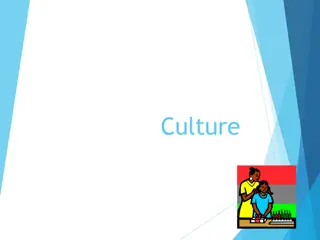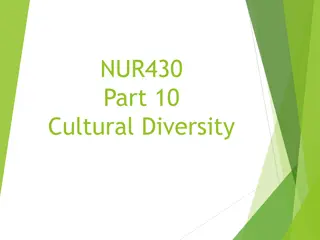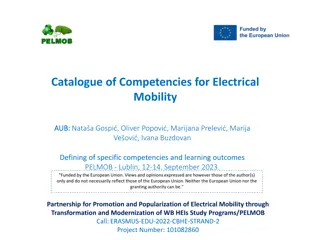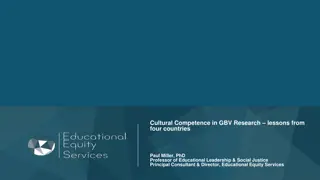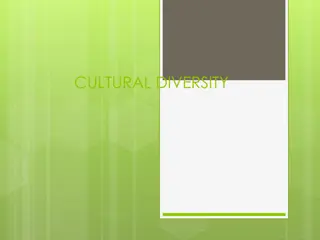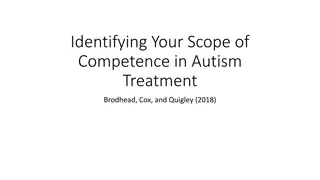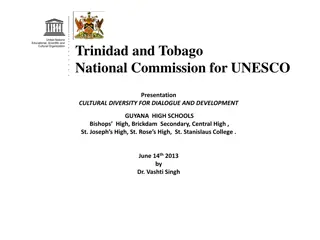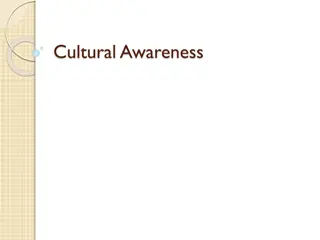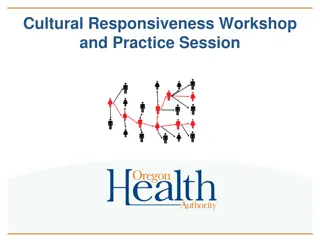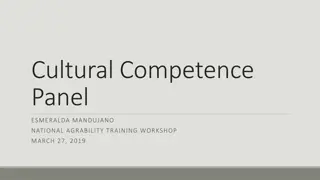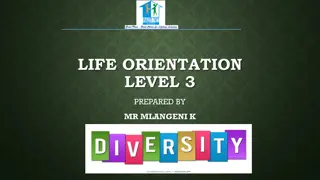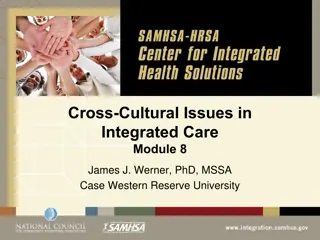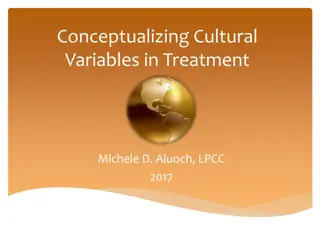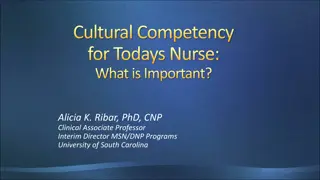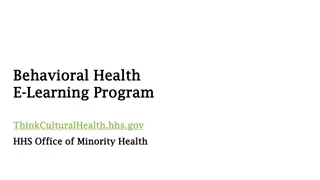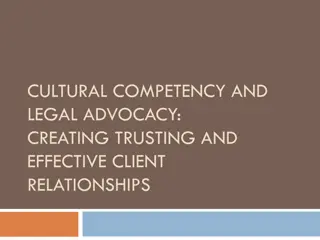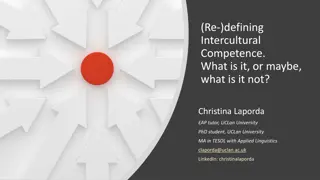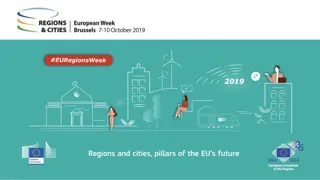Understanding Cultural Competence and Diversity in Society
Explore the significance of cultural competence, diversity, and the elements that define a culture. Learn how cultural differences shape societies and the importance of acceptance and understanding. Enhance your awareness of various cultures and their contributions to our global community.
Download Presentation

Please find below an Image/Link to download the presentation.
The content on the website is provided AS IS for your information and personal use only. It may not be sold, licensed, or shared on other websites without obtaining consent from the author. Download presentation by click this link. If you encounter any issues during the download, it is possible that the publisher has removed the file from their server.
E N D
Presentation Transcript
Cultural Competence Transracial Placement
Are we all from the same? Of course not
We are All Equal in Christ Leviticus 19:18 Do not seek revenge or bear a grudge against one of your people that love your neighbor as yourself Leviticus 19:34 The alien living with you must be treated as one of your native-born love him as yourself for you were aliens in Egypt Romans 3:29 Is the God the God of Jews only? Is he not the God of Gentiles to? Yes, of Gentiles too. Ephesians 3:6 This mystery is that through the gospel the Gentiles are ears together with Israel members together of one body and shares together in the promise in Christ Jesus.
What is Culture? A group s beliefs norms institutions and communication patterns. A learned way of living shared by a group of people.
What are some characteristics that define or make up a culture? Language Religion Music Art Traditions Holidays Education Politics Economics Recreation & Leisure Activities Others?
Cultural Diversity It is important to recognize that cultural differences exist and to develop an understanding and acceptance of different cultural norms. We must be able to understand the value of local, national and global contributions of all cultures in our society.
Cultural Similarity Religion Spirituality Values Games Music Rites of Passage Education Leadership Family Units Family Traditions
Cultural Competence Cultural Competence can be described as an ability to interact effectively with people of different cultures. Cultural competence comprises four components.
Cultural Competence Awareness - Awareness is consciousness of one s personal reactions to people who are different. (example: a police officer who recognizes that he profiles people who look like they are from Mexico as illegal aliens has cultural awareness of his reactions to this group of people.) Attitude - Participants should carefully examine their own beliefs and values about cultural differences.
Cultural Competence Knowledge - Our values and beliefs about equality may be inconsistent with our behaviors, and we may not be aware of it. Skills - The skills component focuses on practicing cultural competence to perfection. Communication is the fundamental tool by which people interact in organizations. This includes gestures and other non-verbal communication that tend to vary from culture to culture.
Cultural Competence Developing cultural competence results in an ability to understand, communicate with and effectively interact with people across cultures.
Cultural Heritage The practices, representations, expressions, knowledge, skills - as well as the instruments, objects, artifacts and cultural spaces associated to - that communities groups and, in some cases, individuals recognize as part of their cultural heritage.
Cultural Heritage This intangible cultural heritage, transmitted from generation to generation, is constantly recreated by communities and groups in response to their environment, their interaction with nature and their history, and provides them with the sense of identity and continuity, thus promoting respect for cultural diversity and human creativity.
Cultural Acculturation An exchange of cultural features that results when groups come into continuous first-hand contact; the original cultural patterns of either or both groups may be altered, but the groups remain distinct. All cultures, with very few exceptions, have been influenced by foreign cultures. Ideas and arts have been borrowed and developed.
Stereotype A commonly held public belief about specific social groups or types of individuals. The concepts of stereotypes and prejudice are often confused with many other different meanings.
Stereotype Stereotypes are standardized in simplified conceptions of groups based on some prior assumptions. Generally speaking, stereotypes are not based on objective truth but rather subjective and sometimes unverifiable content matter.
Prejudice A Prejudice is a prejudgment or a preconceived belief, opinion, or judgement made without ascertaining the facts of the case.
Prejudice The word prejudice is most commonly used to refer to a preconceived judgement toward a people or a person because of race, social class, gender, ethnicity, age, disability, political beliefs, religion, sexual orientation or other personal characteristics. It also means our priority beliefs (without knowledge of the facts) and may include any unreasonable attitude that is unusually resistant to rational influence. Although positive and negative prejudice both exist, when use negatively, prejudice implies fear and antipathy toward such a race.
Prejudice Cognitive Prejudice refers to what people believe to be true. Affective Prejudice refers to what people like and dislike for example, and attitudes toward members of particular classes such as race, ethnicity, national origin, or creed. Behavioral Prejudice refers to how people are inclined to behave. It is regarded as an attitude because people do not act on their feelings. An example of cognitive prejudice baby found an expression of what should be done if the opportunity presents itself.
Prejudice These three types of prejudice are correlated, but all need not be present in a particular individual. Someone may believe that a particular group possesses low levels of intelligence, but harbor no ill feelings towards that group. Group may be disliked because of intense competition for jobs, but still recognize no differences between groups.
Discrimination Discrimination is a behavior (an action), with reference to unequal treatment of people because they are members of a particular group. Three categories of discrimination are:
Discrimination Personal / Individual Discrimination is directed toward a specific individual and refers to any act that leads to unequal treatment because of individuals real or perceived group membership.
Discrimination Legal Discrimination refers to unequal treatment, on the grounds of group membership, that is upheld by law. Apartheid is an example of legal discrimination against black South Africans, as are also various post-Civil War laws in the Southern United States that legally disadvantaged African-Americans, with respect to property rights, employment rights, permission to pass a white residential area and exercise of constitutional rights.
Discrimination Institutional Discrimination refers to unequal treatment that is entrenched in basic social institutions resulting in advantaging one group over another. The Indian caste system and European feudal system are historical examples of institutional discrimination. Present-day policies seen as institutional discrimination are Islamic law moral codes concerning the status of women in Saudi Arabia.
Discrimination As with prejudice generally, these three types of discrimination are correlated and may be found to varying degrees in individuals and society at large. Many forms of discrimination based upon prejudice are outwardly acceptable in most societies.
Ethnic Group / Ethnicity An ethnic group is a group of people whose members identify with each other, through a common heritage that is real or assumed.
Ethnic Group / Ethnicity This shared heritage may be based upon believed or acknowledged common ancestry, history, kinship, religion, language, shared territory, nationality or physical appearance. Members of an ethnic group are conscious of belonging to an ethnic group; moreover ethnic identity is further marked by the recognition from others of a group's distinctiveness.
Race Race is a grouping of people based on biological similarities, such as facial features or color.
Assimilation Assimilation is a process of integration where members of an ethno-cultural community, such as immigrants or ethnic minorities, are absorbed into another, larger community. It implies the loss of the characteristics of the absorbed group, such as language, customs, ethnicity and self-identity.
We all have preconceived notions about how things work, or how we think they are supposed to work. We've come too many of these conclusions through our own personal experiences and can be easily lulled into complacency in assessing who others are and what they may need from us.
When a child comes into our care we must collect information through our interactions to be able to understand what services they need (including cultural needs that may be a challenge for caregivers to provide), where their strengths lie, and what their challenges or deficits may be.
Transracial Placement Howard M. Metzenbaum Multiethnic Placement Act of 1994 (MEPA) Prohibits an agency or entity that receives federal assistance and is involved in adoptive or foster care placement from delaying or denying the placement of a child on the basis of the race, color or national origin of the adoptive or foster parent or the child involved.
Transracial Placement Interethnic Adoption Provisions (IEP), 1996 Forbids agencies from denying or delaying placement of a child for adoption solely on the basis of race or national origin, stating that discrimination is not to be tolerated.
Transracial Placement Specific Intentions of MEPA & IEP Decrease the length of time that children want to be adopted Facilitate the recruitment and retention of foster adoptive parents who can meet the distinctive needs of children awaiting placement To eliminate discrimination on the basis of race, color or national origin of the child or the prospective parent
Perspectives on Transracial Adoption Adoption is a response to a life crisis. It is a turning point, separating everything that comes before from what happens after. A decision that forces us to confront the most basic goals of life, it foster's change and growth for all who are touched by it.
Perspectives on Transracial Adoption Race Matters. When parents are raising a child of a race different from their own, the parents lack of experience with the race of the child s birth heritage creates challenges for all members of the family.
Perspectives on Transracial Adoption Adoptive families have the desire and capacity to help themselves. Asking for help is not an expression of weakness or defeat, but a show of strength, even though you may not be feeling particularly strong at the moment. The alternative, to become passive and not to reach out to find a useful action, is a response that will not serve your family. Our hope for this book is to support your positive desire to stretch as far as you can for your family.
Perspectives on Transracial Adoption Transracial adoption issues are not easy or comfortable subjects to discuss. Support from well- meaning friends and family is often not enough. This book exists to serve the special needs of adoptive parents of children of color by providing tools to explore the issues and consider suggestions toward resolution. Breaking through the isolation and discovering how others handle similar situations can be a great relief.
Self-Assessment Personality Issues Each of us is hardwired in particular ways. That means we are comfortable in certain types of circumstances and are likely to make life choices that reflect our particular personality traits. Although personality traits are not usually changeable, understanding who you are can enable you to decide whether your temperament will lend itself comfortably to the issues you and your family will face.
Self-Assessment Personality Issues Being prepared for and able to cope with your own emotions about the issues transracial adoption raises makes a great difference. Think about whether or not these are challenges for you. Attracting attention Seeking help Facing complexity Valuing multiple points of view
Self-Assessment Attitude Acknowledging your own racism and adoptism is painful. If you think that racism is lessening, you probably aren't dealing with it much. If you think that most people feel adoption is a good thing, you probably haven t yet had the opportunity to experience people s special reactions to special families. If you haven t had much experience with these issues, your antennae are probably not yet well- developed.
Self-Assessment Lifestyle Day-to-day living, what we do, what we see, where we go. This is how and where children learn the most important lessons of their lives. More than our words, and regardless of our intentions, children take our actions to heart. If there are many people of color important to your life, you will deliver the message that people of color are important and valued. If your child is the only one, how will you avoid the message that she is an exception to her race, that there is something wrong with her ethnicity?
Self-Assessment Knowledge Schools teachers mostly European-based history and knowledge. Society teaches us to view the world from the point of view of White America, point of view that sometimes includes immigrant bashing or minority bashing to justify our history and current actions. Without positive history in a realistic understanding of current race-based realities in society, children will think that white is better and that people of color have accomplished little in their world.
A Transracially-Adopted Child s Bill of Rights Every child is entitled to love and full membership in their family. Every child is entitled to have their culture embraced and valued. Every child is entitled to parents who know that this is a race-conscious society.
A Transracially-Adopted Child s Bill of Rights Every child is entitled to parents who know that the child will experience life differently than they do. Every child is entitled to parents who are not looking to save them or improve the world. Every child is entitled to parents who know that being in a family doesn t depend on matching.
A Transracially-Adopted Child s Bill of Rights Every child is entitled to parents who know that transracial adoption changes the family forever. Every child is entitled to be accepted by extended family members. Every child is entitled to parents who know that if they are white, they benefit from racism.
A Transracially-Adopted Child s Bill of Rights Every child is entitled to parents who know they can t transmit the child s birth culture if it is not their own. Every child is entitled to have items at home that are made for and by people of their race. Every child is entitled to opportunities to make friends with people of their own race or ethnicity.
A Transracially-Adopted Child s Bill of Rights Every child is entitled to daily opportunities of positive experiences with their birth culture. Every child is entitled to build racial pride within their own home, school and neighborhood. Every child is entitled to have many opportunities to connect with adults of their own race.
A Transracially-Adopted Child s Bill of Rights Every child is entitled to parents who accept, understand and empathize with their culture. Every child is entitled to learn survival, problem- solving and coping skills in a context of racial pride.
A Transracially-Adopted Child s Bill of Rights Every child is entitled to take pride in the development of a dual identity and a multicultural/multiracial perspective on life. Every child is entitled to find his multiculturism to be an asset and to conclude, I ve got the best of both worlds.


